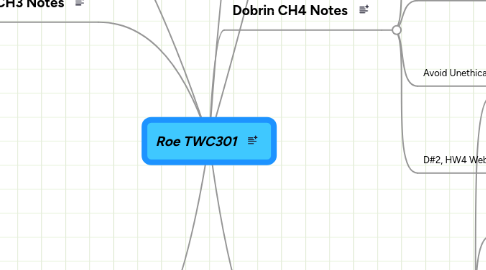
1. Characteristics of technical and professional communication
1.1. Rhetorical
1.2. Audience
1.3. Technology oriented
1.4. Ethical
1.5. Research Oriented
1.6. Professional
1.7. Visual
1.8. Design centered
1.9. Concise
2. Dobrin CH1 Notes
2.1. Problem Solving Approach (PSA)
2.1.1. Plan
2.1.2. Research
2.1.3. Draft
2.1.4. Review
2.1.5. Distribute
2.2. D#1,HW14 HTW
2.2.1. Layout and Design
2.2.2. Visuals
2.2.3. Documenting Sources
2.2.4. Mechanics
2.2.5. Grammar
3. Dobrin CH3 Notes
3.1. Creating Documents
3.1.1. word processors
3.1.2. graphics and imaging software
3.1.3. presentation software
3.1.4. web authoring software
3.1.5. desktop publishing software
3.1.6. help and e-learning authoring tools
3.1.7. single sourcing programs
3.2. Collaborating and Communicating
3.2.1. internet
3.2.2. world wide web
3.2.3. e-mail
3.2.4. ethics and electronic communication
3.2.5. electronic messaging
3.2.6. videoconferencing
3.2.7. groupware
3.3. The Future of Workplace Writing and Computer Technology
3.3.1. bandwidth
3.3.2. integration and portability
3.3.3. prices
3.3.4. transnationalism
3.4. D#2,HW3 HTW Notes
3.4.1. Conducting Meetings from Remote Locations (HTW p. 324)
3.4.2. Presentations (HTW p.391)
3.4.3. PDF Files (HTW p. 574)
4. Dobrin CH5 Notes
4.1. Key Points of Difference
4.1.1. Technolgy
4.1.2. Education
4.1.3. Politics and Law
4.1.4. Economics
4.1.5. Society
4.1.6. Religion
4.2. avoid stereotyping
4.3. Enhance Translation
4.4. Guidelines for Writing for Transnational Audiences
4.4.1. write clearly
4.4.2. Localize Your Writing
4.4.3. Account for Visual and Auditory Perceptions
4.5. D#3,HW3 HTW Notes
4.5.1. global communication (HTW p.228)
4.5.2. Croos-Cultural Examples (HTW p. 265)
4.5.3. Writers Checklist (HTW p.269)
5. Dobrin CH2 Notes
5.1. Thinking Rhetorically
5.1.1. exigency
5.1.2. workplace writer
5.1.3. audience
5.1.4. document
5.1.5. contextual factors and constraints
5.2. D#2,HW2 Web Resources
5.2.1. http://www.boisestate.edu/wcenter/ww82.htm
5.2.2. http://wps.ablongman.com/long_callaghan_mm_1/0,8239,1019864-,00.html
5.2.3. http://collegewriting.org/index.php/strategies/thinking-rhetorically
5.2.4. http://www.consumerculturetheory.org/Members/poe/presentations-cctc06/Linda%20Scott%20-%20Thinking%20Rhetorically.pdf
6. Dobrin CH4 Notes
6.1. Ethics
6.1.1. metaethics
6.1.2. normative ethics
6.1.3. applied ethics
6.2. Ethical Guidelines for Workplace Writers
6.2.1. Ethics and Laws are not the same
6.2.2. be honest
6.2.3. respect confidentiality
6.3. Avoid Unethical Writing
6.3.1. dont use deceptive or evasive language
6.3.2. dont obscure or misrepresent the issue
6.4. D#2, HW4 Web Resources
6.4.1. http://www.jeanweber.com/newsite/?page_id=22
6.4.2. http://portal.acm.org/citation.cfm?id=185044.185046
6.4.3. http://wps.ablongman.com/long_lannon_techcomm_9/2/541/138586.cw/index.html
7. Dobrin CH7 Notes
7.1. D#3,HW4 HTW Notes
7.1.1. organization (HTW p.361)
7.1.2. advantages of outlining (HTW p.363)
7.1.3. content management (HTW p.97)
7.2. Predrafting Strategies
7.2.1. confirm the purpose
7.2.2. analyze your audience
7.2.3. gather info
7.2.4. develope ideas about the info
7.2.5. organize your info
7.3. Types of Organizing
7.3.1. sequential
7.3.2. order of importance
7.3.3. general/specific
7.3.4. division
7.3.5. classification
7.3.6. cause and effect
7.3.7. comparison/contrast
7.3.8. spatial
7.4. Writing the Draft
7.4.1. write the main body first
7.4.2. write the conclusion second
7.4.3. finish with the intro
